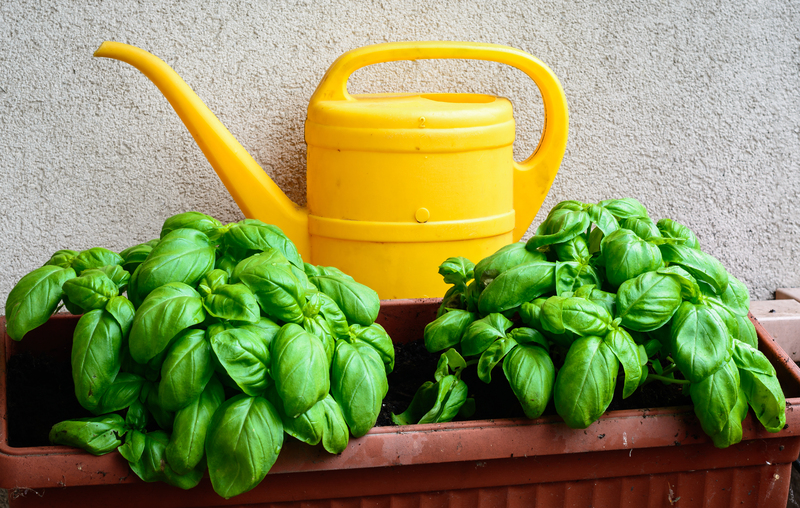Vertical gardening: Reach new heights in greenery
Posted on 16/08/2025
Vertical Gardening: Reach New Heights in Greenery
Vertical gardening is more than a trend--it's a revolutionary approach to maximizing green space in homes, offices, and urban settings. As cities grow denser and available land dwindles, harnessing vertical spaces offers a sustainable, beautiful, and practical solution for bringing nature into our lives. Whether you're a novice or seasoned gardener, vertical gardens can transform bland walls and tight corners into thriving oases. This comprehensive guide explores the world of vertical gardening and shows you how to elevate your greenery--literally!
What is Vertical Gardening?
At its core, vertical gardening involves growing plants upward, making use of walls, fences, trellises, and other vertical structures. Unlike traditional gardening, which relies on horizontal ground area, this method enables gardeners to:
- Maximize limited space
- Add aesthetic value to homes and workplaces
- Improve air quality indoors and outdoors
- Create privacy and reduce noise pollution
- Enhance urban biodiversity
Sometimes referred to as living walls or green walls, vertical gardens can be simple DIY setups or elaborate, architecturally integrated masterpieces.

Benefits of Vertical Gardening
Vertical gardens are rapidly gaining popularity for a number of compelling reasons. Let's delve into some of the major advantages:
1. Saving Space and Increasing Planting Area
For urban dwellers, vertical gardens offer a chance to enjoy lush greenery even when outdoor space is at a premium. Patios, balconies, or even kitchen walls can harbor extensive gardens. This approach allows you to multiply your planting area without encroaching on precious living space.
2. Improving Aesthetics
Vertical greenery transforms drab walls into vibrant, living art pieces. Whether you choose a cascading display of flowers, a tapestry of moss, or an edible wall of herbs, your vertical garden is sure to become a focal point that delights the eyes and soothes the soul.
3. Enhancing Air Quality
Plants are natural air purifiers. A vertical garden can help remove toxins, filter dust, and increase oxygen in both outdoor and indoor environments. This is especially beneficial for improving the health and wellbeing of inhabitants in homes and office buildings.
4. Energy Efficiency
A properly placed living wall can act as insulation, reducing heating and cooling costs in buildings. Plants help moderate temperature by providing shade and reducing heat absorption, while also increasing humidity through transpiration.
5. Supporting Biodiversity
Vertical gardening creates microhabitats for insects, birds, and pollinators, helping to sustain urban ecology. In cities, every patch of greenery counts toward supporting wildlife.
6. Accessibility and Ergonomics
No more bending, stooping, or kneeling--vertical gardens put plants at a convenient height, making gardening accessible for people with mobility challenges or physical limitations. Maintenance is often easier, too.
Types of Vertical Gardens
There are many ways to embrace vertical gardening, each offering flexibility, function, and flair. Here are the most popular types:
1. Living Walls / Green Walls
These are perhaps the most iconic versions of vertical gardens. Living walls use panels anchored to structures, with slots for planting. Irrigation systems can be integrated for automated watering. Living walls can stretch indoors across lobbies and meeting rooms or cloak outdoor facades.
2. Trellises and Lattice Structures
These are ideal for climbing plants like vines, beans, and cucumbers. Trellises can be attached to walls, freestanding, or even incorporated into fences. Their open design offers support while providing airflow and sunlight.
3. Vertical Planters and Pockets
Outdoor or indoor planters stacked vertically, wall-mounted pockets, and hanging systems are suitable for a variety of small plants, from lettuces and herbs to succulents and flowers. These systems are perfect for renters or DIY enthusiasts.
4. Modular Systems
Pre-fabricated panels or stackable containers can be customized to fit any space and scale up easily. These systems often include integrated watering, lighting, and even smart sensors.
5. Pallet Gardens
Repurposing wood pallets to hold containers or soil pouches is a sustainable and cost-effective way to create a vertical vegetable garden on a balcony or patio.
6. Gutter Gardens
Old rain gutters mounted horizontally to a wall can hold a row of shallow-rooted plants. This creative approach is perfect for herbs, strawberries, and leafy greens.
Getting Started: Planning Your Vertical Garden
Before you make your first planting, consider these crucial factors to ensure your vertical garden thrives:
- Location: Determine whether your garden will be indoors or outdoors. Assess how much sunlight and wind the space receives.
- Structure and Support: Choose a support system that suits your chosen plants and available wall or fence space. Consider weight and anchoring needs, especially for larger installations.
- Watering and Drainage: Vertical gardens can dry out more quickly than ground-based beds. Plan an irrigation system or select drought-tolerant plants to reduce maintenance.
- Plant Selection: Choose plants with similar light and water needs. Fast-growing climbers, trailing plants, succulents, herbs, and small edible crops are all excellent choices.
- Soil and Fertilization: Use high-quality potting mixes that drain well and supply necessary nutrients. Remember that vertical planters may need more frequent feeding.
Best Plants for Vertical Gardens
Success in vertical gardening depends heavily on choosing the right plants. Here are some favorites for different conditions:
For Sunny Locations
- Succulents (e.g. Sedum, Echeveria, Crassula)
- Herbs (Basil, Oregano, Rosemary, Thyme)
- Flowering Annuals (Petunias, Nasturtiums, Calendula)
- Fruiting Plants (Strawberries, Cherry Tomatoes)
For Shady Sites
- Ferns (Boston Fern, Maidenhair Fern)
- Calathea and other shade-loving houseplants
- Hostas
- Ivies and Trailing Philodendrons
For Indoors
- Pothos
- Spider Plant
- Peace Lily
- English Ivy
- Small-leaved Ficus
For Edible Walls
- Lettuce
- Spinach
- Arugula
- Strawberries
- Herbs (noted above)
How to Build a Vertical Garden: Step by Step
Ready to unleash your creativity and go vertical with your garden? Follow these essential steps:
1. Select the Right Site
Look for a wall or fence that gets suitable sunlight and is accessible for care and maintenance. If indoors, consider proximity to windows or grow lights.
2. Choose a Vertical Garden System
Decide whether to use wall pockets, stand-alone frames, trellises, or modular systems, depending on space and budget.
3. Plan the Design
Map out your vertical gardening design. Mix and match foliage colors, textures, and shapes for striking visual appeal.
4. Install Support Structures
Secure planters, racks, or trays to the wall, ensuring they can handle the weight of mature plants and wet soil. Always use sturdy hardware and anchors.
5. Prepare Planting Medium
Fill planters, pockets, or containers with quality potting soil or a hydroponic medium if preferred. For living walls, insert root modules or matting.
6. Plant Selection and Placement
Arrange plants according to their growth habits and lighting needs. Place trailing species at the top to cascade downward and upright plants below.
7. Irrigation and Fertilization
Install drip irrigation for easy, consistent watering, or soak and mist as needed. Feed with a diluted liquid fertilizer during the growing season for lush results.
Maintenance Tips for Flourishing Vertical Gardens
Like any garden, vertical installations need regular care. Here's how to keep your living wall lush and healthy:
- Check moisture: Vertical gardens often dry out faster; inspect soil daily in hot weather.
- Prune regularly: Trim overgrown stems to keep plants tidy and prevent crowding.
- Monitor for pests: Inspect leaves for aphids, mites, and other issues; treat promptly.
- Fertilize: Use a balanced, water-soluble fertilizer once a month or as needed.
- Rotate plants: Swap out tired or ailing specimens to keep the display fresh.
Creative Vertical Gardening Ideas
Vertical gardening is endlessly adaptable. Here are some innovative approaches to inspire your next project:
- Kitchen Herb Wall: Grow culinary herbs in wall-mounted planters for easy access and fresh flavors every meal.
- Privacy Screen: Use a trellis covered in vines to create a green divider between patios or balconies.
- Upcycled Shoe Organizer: Repurpose an old fabric shoe holder as a series of plant pockets for small annuals or edibles.
- Painted Pallet Wall: Add a burst of color by painting a recycled pallet and filling it with cheerful blooms.
- Indoor Moss Art: Adorn a living room wall with sculpted moss designs--virtually maintenance-free!
Vertical Gardening Tips for Beginners
Starting your own vertical garden might seem daunting, but these insider tips can make the journey smoother:
- Start small: Experiment with a few wall-mounted pots before expanding to larger systems.
- Keep it light: Choose lightweight containers and potting mixes to reduce stress on your support structure.
- Think modular: Modular planters can be added or removed for easy rearrangement and plant rotation.
- Don't overwater: Excess moisture can leach down and cause root rot--err on the side of caution.
- Research plant needs: Group plants by similar water, light, and nutrient requirements.

Future of Vertical Green Spaces
As urbanization accelerates and environmental awareness grows, the future of vertical gardening looks brighter than ever. Technologies such as hydroponics, automated irrigation, and energy-efficient grow lights have made even large-scale indoor green walls feasible for apartments, offices, and public buildings. Around the world, vertical urban farms now supply fresh produce to neighborhoods with limited access to farmland, helping build food security and lower carbon footprints.
Incorporating greenery into architectural design isn't just about beauty--it's about resilience, sustainability, and health. As vertical gardening continues to reach new heights in greenery, it redefines our relationship with plants and urban spaces.
Conclusion: Elevate Your Space with Vertical Gardening
Whether you're looking to maximize limited space, create a show-stopping feature wall, or simply enjoy more plants in your daily life, vertical gardening offers endless opportunities for creativity and growth. By embracing this innovative approach, you don't just decorate--you transform your home, support local ecosystems, and contribute to a greener, cleaner future.
Why not reach new heights in greenery? Start your vertical garden today, and watch your world bloom upward!

